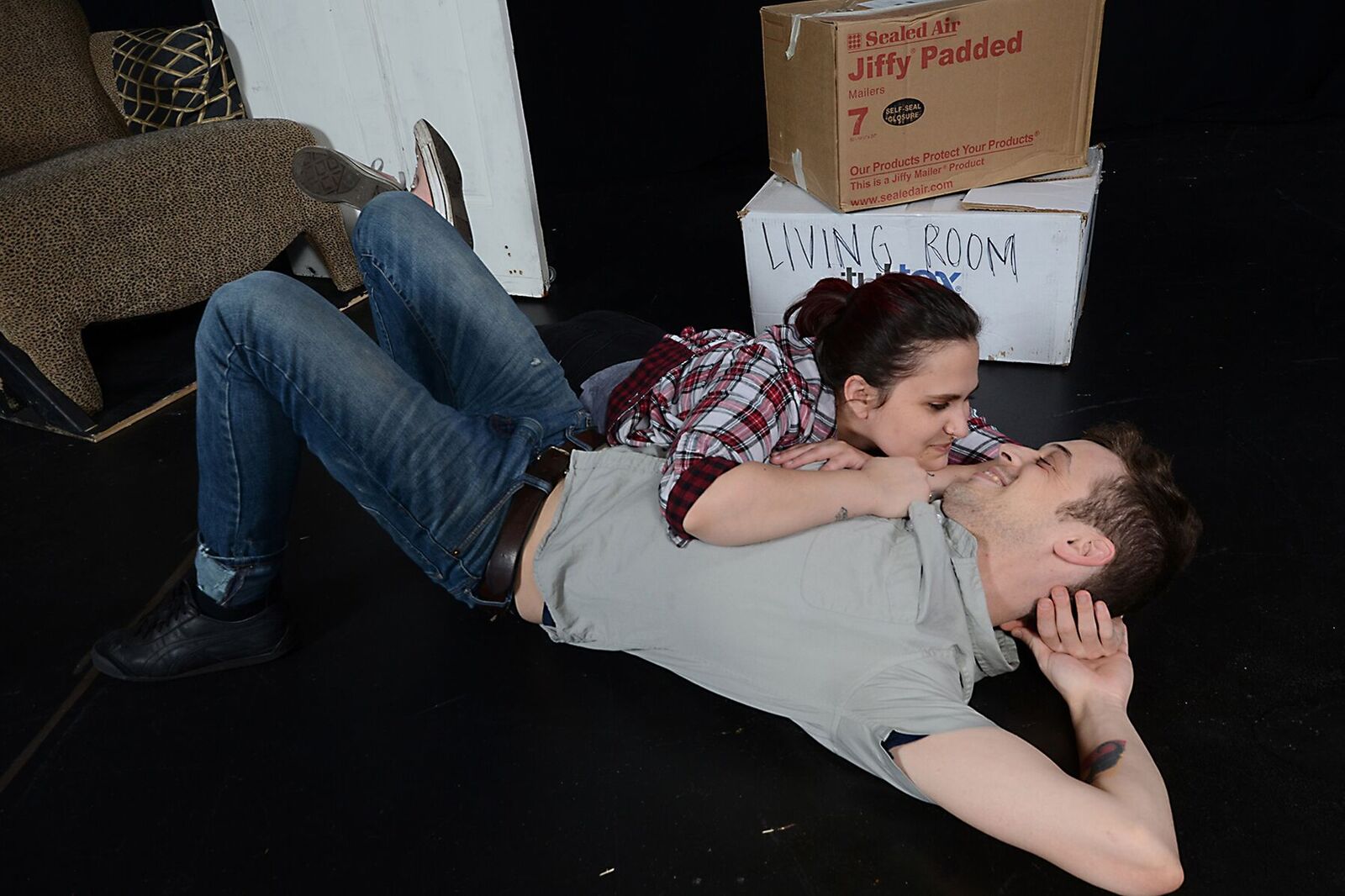Brandon Meeks & J. Barrett Cooper in Red. Photo by Hannah Greene.
Red
By John Logan
Directed by Steve Woodring
Review by Katherine Dalton
Entire contents copyright © 2018 Katherine Dalton. All rights reserved.
In 1958, Mark Rothko was commissioned by Philip Johnson to paint 600 square feet of canvas for the walls of what would become the Four Seasons restaurant, in Mies van der Rohe’s new Seagram skyscraper on Park Avenue in New York City. Rothko normally worked without help, but for this large commission he hired an assistant. The play Red opens with that assistant’s first day, and follows the two men over two years they stretch canvas, paint, and argue about art.
This Bunbury production is housed in an excellent set by Tom Tutino, but talky as this play is its success depends heavily on Steve Woodring’s direction and the abilities of its actors. Brandon Meeks, as Ken, Rothko’s new assistant, portrays a nice combination of indefiniteness and callow opinion as the foil for Rothko’s philosophizing and his anger. J. Barrett Cooper, as the painter, has the difficult task of maintaining the constant tension of his character in a play full of aggressive debate that nevertheless needs moments of respite. He does an excellent job of conveying both the assertive intensity and the underlying despair that plagued Rothko, and that eventually caused him to take his life in 1970.
Set as the play is over a decade earlier, most of it is about the purposes of art, as Rothko saw them. Competitive and dismissive of his immediate predecessors and contemporaries, he takes the Freudian view that every emerging artist must, like Oedipus, “kill” his artistic father. In Rothko’s case it was the “death” of Cubism that allowed for the emergence of his own Abstract Expressionism. Originality as he would define it must then be something utterly new in not just expression but in form.
The rub is, that while achieving critically acclaimed newness may be satisfying for a man as he makes his career, after a lifetime of work his newness is no longer new. That means that the successful son must, in turn, become the supplanted father—and that there can be no permanent importance to what he does. For a man prone to depression, as Rothko apparently was, this is not a philosophy to live by. “You grow superfluous in your own lifetime,” Rothko says at once point in the play. And more tellingly: “Silence is so accurate.” Rothko was an intelligent man and full of quips. But that latter one is only true about despair.
For anyone who likes to debate art and aesthetics, this play is full of matter. Should art be “serious” or is it ethical to paint what people want, or what Ken describes as “painting for right now and a little bit ahead”—one of Rothko’s beefs with Pop Art? Is it true that romanticism in art is “not honest”? Is it true that representational pictures do not require the participation of the viewer the way abstraction does? Is the most important quality of great art that it is “original”? And is the correct definition of originality something utterly new that no one has ever done before, and does “utterly new” mean form must be exploded? There is a lot to wrangle with here.
As for the paintings whose creation is at the center of this play, according to some accounts Rothko initially thought they were to decorate the lobby of the Seagram building, and was appalled when he found out they were to decorate the restaurant instead. But it is more likely he knew exactly what this princely commission was for and had second thoughts as he got closer to completion. The playwright seems to think so, and the last bit of artistic debate—and to my ear the least satisfying—is about our modern preoccupation with the tension between art and commerce.
Still, however one might agree or disagree with Rothko’s artistic views, they are widely held and well worth examining, and this play is willing to examine them. This makes for a very satisfying 90 minutes of wrestling with our very human desire to create and to destroy, to see and to be seen.
Red
Bunbury Theatre
in collaboration with ShPiel Theatre Identity
February 16 – March 4, 2018
Bunbury Theatre at
The Henry Clay Theatre
604 South 3rd St.
Louisville, KY 40202
502-585-5306
For tickets and more info go to BunburyTheatre.org.
 Katherine Dalton has written for publications ranging from the Wall Street Journal to Harper’s Bazaar, and contributed to the books Wendell Berry: Life and Work and Conservations with Wendell Berry. She lives in Louisville.
Katherine Dalton has written for publications ranging from the Wall Street Journal to Harper’s Bazaar, and contributed to the books Wendell Berry: Life and Work and Conservations with Wendell Berry. She lives in Louisville.





